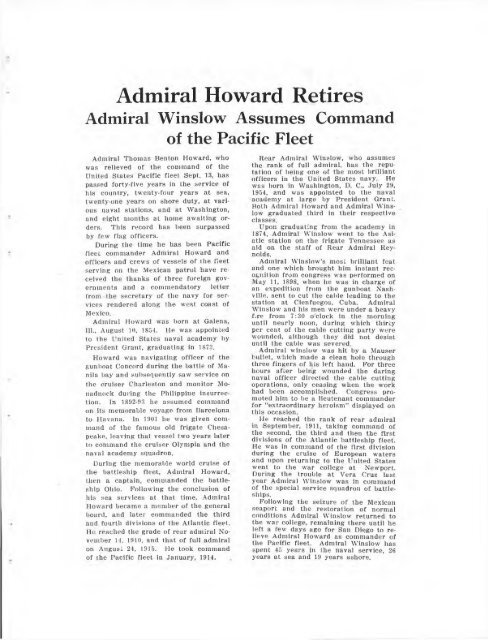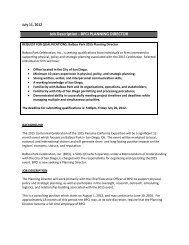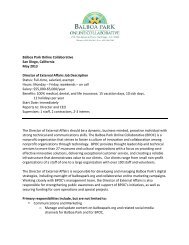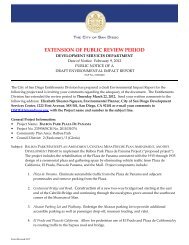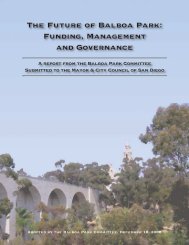Army and Navy Review 1915 Panama-California Edition - Balboa Park
Army and Navy Review 1915 Panama-California Edition - Balboa Park
Army and Navy Review 1915 Panama-California Edition - Balboa Park
You also want an ePaper? Increase the reach of your titles
YUMPU automatically turns print PDFs into web optimized ePapers that Google loves.
Admiral Howard Retires<br />
Admiral Winslow Assumes Comm<strong>and</strong><br />
of the Pacific Fleet<br />
Admiral Thomas Benton Howard, who<br />
was relieved of the comm<strong>and</strong> of the<br />
United States Pacific fleet Sept. 13, has<br />
passed forty-five years in ilie service of<br />
his country, twenty-four years at sea,<br />
twenty-one years on shore duty, at various<br />
naval stations, <strong>and</strong> at. Washington,<br />
<strong>and</strong> eight months at home awaiting orders.<br />
This record has been surpassed<br />
by few flag officers.<br />
During the time he has been Pacific<br />
fleet comm<strong>and</strong>er Admiral Howard <strong>and</strong><br />
officers <strong>and</strong> crews of vessels of the fleet,<br />
serving on the Mexican patrol have received<br />
the thanks of three foreign governments<br />
<strong>and</strong> a commendatory letter<br />
from the secretary of the navy for services<br />
rendered along the west coast of<br />
Mexico.<br />
Admiral Howard was born at Galena,<br />
Ill., August 10, 1854. He was appointed<br />
to the United States naval academy by<br />
President Grant, graduating in 1873.<br />
Howard was navigating officer of the<br />
gunboat Concord during the battle of Manila<br />
bay <strong>and</strong> subsequently saw service on<br />
the cruiser Charleston <strong>and</strong> monitor Monadnock<br />
during the Philippine insurrection.<br />
In 1892-93 he assumed comm<strong>and</strong><br />
on its memorable voyage from Barcelona<br />
to Havana. In 1901 he was given comm<strong>and</strong><br />
of the famous old frigate Chesapeake,<br />
leaving that vessel two years later<br />
to comm<strong>and</strong> the cruiser Olympia <strong>and</strong> the<br />
naval academy squadron.<br />
During the memorable world cruise of<br />
the battleship fleet, Admiral Howard,<br />
then a captain, comm<strong>and</strong>ed the battleship<br />
Ohio. Following the conclusion of<br />
his sea services at that time, Admiral<br />
Howard became a member of the general<br />
board, <strong>and</strong> later comm<strong>and</strong>ed the third<br />
<strong>and</strong> fourth divisions of the Atlantic fleet.<br />
He reached the grade of rear admiral November<br />
14. 1910, <strong>and</strong> that of full admiral<br />
on August 24, <strong>1915</strong>. He took comm<strong>and</strong><br />
of the Pacific fleet in January, 1914.<br />
Rear Admiral Winslow, who assumes<br />
the rank of full admiral, has the repu<br />
tation of being one of the most brilliant<br />
officers in the United States navy. He<br />
was born in Washington, D. C., July 29,<br />
1954, <strong>and</strong> was appointed to the naval<br />
academy at large by President Grant.<br />
Both Admiral Howard <strong>and</strong> Admiral Winslow<br />
graduated third in their respective<br />
classes.<br />
Upon graduating from the academy in<br />
1874, Admiral Winslow went to the Asiatic<br />
station on the frigate Tennessee as<br />
aid on the staff of Rear Admiral Reynolds.<br />
Admiral Winslow's most brilliant feat<br />
<strong>and</strong> one which brought him instant recognition<br />
from congress was performed on<br />
May 11, 1898, when he was in charge of<br />
an expedition from the gunboat Nashville,<br />
sent to cut the cable leading to the<br />
station at Cienfuegos, Cuba. Admiral<br />
Winslow <strong>and</strong> his men were under a heavy<br />
fire from 7:30 o'clock in the morning<br />
until nearly noon, during which thirty<br />
per cent of the cable cutting party were<br />
wounded, although they did not desist<br />
until the cable was severed.<br />
Admiral winslow was hit by a Mauser<br />
bullet, which made a clean hole through<br />
three fingers of his left h<strong>and</strong>. For three<br />
hours after being wounded the daring<br />
naval officer directed the cable cutting<br />
operations, only ceasing when the work<br />
had been accomplished. Congress promoted<br />
him to be a lieutenant comm<strong>and</strong>er<br />
for “extraordinary heroism” displayed on<br />
this occasion.<br />
He reached the rank of rear admiral<br />
in September, 1911, taking comm<strong>and</strong> of<br />
the second, the third <strong>and</strong> then the first<br />
divisions of the Atlantic battleship fleet.<br />
He was in comm<strong>and</strong> of the first division<br />
during the cruise of European waters<br />
<strong>and</strong> upon returning to the United States<br />
went to the war college at Newport.<br />
During the trouble at Vera Cruz last<br />
year Admiral Winslow was in comm<strong>and</strong><br />
of the special service squadron of battleships.<br />
Following the seizure of the Mexican<br />
seaport <strong>and</strong> the restoration of normal<br />
conditions Admiral Winslow returned to<br />
the war college, remaining there until he<br />
left a few days ago for San Diego to relieve<br />
Admiral Howard as comm<strong>and</strong>er of<br />
the Pacific fleet. Admiral Winslow has<br />
spent. 45 years in the naval service, 26<br />
years at sea <strong>and</strong> 19 years ashore.


